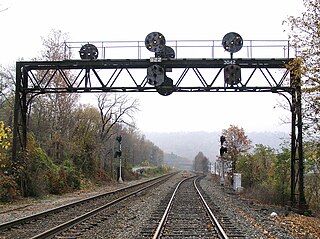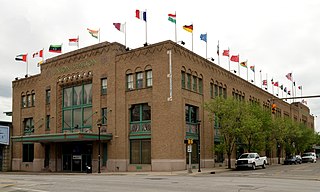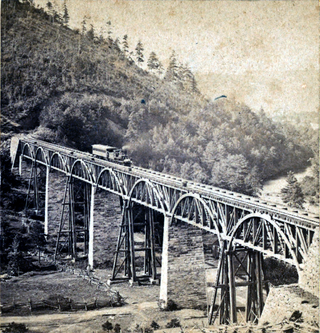The Pennsylvania Railroad Company, also known as the "Pennsy", was an American Class I railroad that was established in 1846 and headquartered in Philadelphia. It was named for the commonwealth in which it was established. At its peak in 1882, the Pennsylvania Railroad was the largest railroad, the largest transportation enterprise, and the largest corporation in the world.

The New York Central Railroad was a railroad primarily operating in the Great Lakes and Mid-Atlantic regions of the United States. The railroad primarily connected greater New York and Boston in the east with Chicago and St. Louis in the Midwest, along with the intermediate cities of Albany, Buffalo, Cleveland, Cincinnati, Detroit, Rochester and Syracuse. New York Central was headquartered in New York City's New York Central Building, adjacent to its largest station, Grand Central Terminal.
The Lehigh Valley Railroad was a railroad built in the Northeastern United States to haul anthracite coal from the Coal Region in Pennsylvania. The railroad was authorized on April 21, 1846, for freight and transportation of passengers, goods, wares, merchandise, and minerals in Pennsylvania and the railroad was incorporated and established on September 20, 1847, as the Delaware, Lehigh, Schuylkill and Susquehanna Railroad Company.
The Genesee Valley Canal Railroad was a part of the Pennsylvania Railroad system in western New York. It was built on the former Genesee Valley Canal alignment.

The Northern Central Railway (NCRY) was a Class I Railroad connecting Baltimore, Maryland with Sunbury, Pennsylvania, along the Susquehanna River. Completed in 1858, the line came under the control of the Pennsylvania Railroad (PRR) in 1861, when the PRR acquired a controlling interest in the Northern Central's stock to compete with the rival Baltimore and Ohio Railroad (B&O).
The Elmira and Lake Ontario Railroad was a subsidiary of the Northern Central Railway and later the Pennsylvania Railroad, formed to give the Northern Central an outlet for coal traffic on Lake Ontario.

The Lycoming Valley Railroad is a short line that operates 38 miles (61 km) of track in Lycoming and Clinton counties in Pennsylvania in the United States. It is part of the North Shore Railroad System.

The Buffalo Line is a railroad line owned by the Norfolk Southern Railway in the U.S. states of New York and Pennsylvania. The line runs from Buffalo, New York southeast to Rockville, Pennsylvania near Harrisburg, Pennsylvania along a former Pennsylvania Railroad line. Its north end is at Seneca Yard in Buffalo, with no direct access to the Lake Erie district, and its south end is at the Pittsburgh Line at Rockville. The line is operated by the Buffalo and Pittsburgh Railroad between Buffalo and Machias, New York, the Western New York and Pennsylvania Railroad between Machias and Driftwood, Pennsylvania, and the Norfolk Southern Railway between Driftwood and Rockville.

The Schuylkill Branch was a rail line owned and operated by the former Pennsylvania Railroad (PRR) in the U.S. state of Pennsylvania. The line ran from the Philadelphia to Harrisburg Main Line at 52nd Street in Philadelphia north via Norristown, Reading, and Pottsville to Delano Junction. From Delano Junction, the PRR had trackage rights over the Lehigh Valley Railroad's Hazleton Branch and Tomhicken Branch to Tomhicken, where the PRR's Catawissa Branch began. In conjunction with the Catawissa Branch, Nescopeck Branch, and Wilkes-Barre Branch, the Schuylkill Branch gave the PRR a direct line from Philadelphia to Wilkes-Barre.

Union Station is an Amtrak railroad station and mixed-use commercial building in downtown Erie, Pennsylvania, United States. It is served by the Lake Shore Limited route, which provides daily passenger service between Chicago and New York City or Boston; Erie is the train's only stop in Pennsylvania. The station's ground floor has been redeveloped into commercial spaces, including The Brewerie at Union Station, a brewpub. The building itself is privately owned by the global logistics and freight management company Logistics Plus and serves as its headquarters.
The Bald Eagle Valley Railroad was a subsidiary of the Pennsylvania Railroad which owned several rail lines in central Pennsylvania. It had its genesis in the Tyrone and Lock Haven Railroad, a financially troubled railroad chartered in 1857, which was unable to complete more than a small portion of its line before it was reorganized as the Bald Eagle Valley and funded by the PRR in 1861. Completed from Tyrone to Lock Haven in 1865, it was completely controlled by the PRR and did not operate independently. However, it retained its corporate existence for some time, acquiring branch lines into the Snowshoe coal region and an extension from Bellefonte to Lemont before being merged into the PRR in 1908.
The Philadelphia, Newtown and New York Railroad was a railroad in southeastern Pennsylvania that is now a part of the SEPTA commuter rail system as the Fox Chase Branch. Despite the name, it only ever extended between Philadelphia and Newtown, Pennsylvania.

The Western New York and Pennsylvania Railroad is a short-line railroad that operates freight trains in Western New York and Northwest Pennsylvania, United States. The company is controlled by the Livonia, Avon and Lakeville Railroad, with which it does not connect. It started operations in 2001 on the Southern Tier Extension, a former Erie Railroad line between Hornell, NY and Corry, PA, owned by the public Chautauqua, Cattaraugus, Allegany and Steuben Southern Tier Extension Railroad Authority (STERA). Through acquisitions and leases, the line was extended from Corry to Meadville, PA in 2002 and to Oil City, PA in 2006. In 2007, the WNY&P leased and sub-leased portions of the north–south Buffalo Line, a former Pennsylvania Railroad line mostly built by a predecessor of the defunct Western New York and Pennsylvania Railway. The two lines cross at Olean, NY.
The Western New York and Pennsylvania Railway was a railroad that operated in the U.S. states of New York and Pennsylvania.

The Philadelphia and Baltimore Central Railroad (P&BC) was a railroad that operated in Pennsylvania and Maryland in the 19th and early 20th centuries. It operated a 110-mile (180 km) main line between West Philadelphia and Octoraro Junction, Maryland, plus several branch lines.

The Catawissa Railroad was a railroad that operated in Pennsylvania between 1860 and 1953. For most of its lifespan it was leased by the Reading Company, and was subsequently merged into the Reading.

The Cleveland, Painesville and Ashtabula Railroad (CP&A), also known informally as the Cleveland and Erie Railroad, the Cleveland and Buffalo Railroad, and the Lake Shore Railroad, was a railway which ran from Cleveland, Ohio, to the Ohio-Pennsylvania border. Founded in 1848, the line opened in 1852. The railroad completed the rail link between Buffalo, New York, and Chicago, Illinois.

The Sunbury and Lewistown Railroad was a Class I Railroad connecting Lewistown, Pennsylvania with Sunbury, Pennsylvania. Completed in December 1871, the line was placed under an immediate lease by the Pennsylvania Railroad (PRR), upon its completion. Although retaining its own board of directors and track maintenance, all locomotive traffic was owned by the PRR. For over eighty years, the line operated between Sunbury and Lewistown, serving as a relief line for both the Philadelphia Main Line and Bald Eagle Valley Railroad through Williamsport, Pennsylvania. The line was noteworthy as a proving ground for new railroad technology in the United States, such as the "X"-shaped railroad crossing signs in 1917 and Pulse Code Cab Signaling technology in 1925. It is now a fallen flag railway, the name "Sunbury and Lewistown" having been phased out in 1901 when the line became part of the Pennsylvania Railroad's Sunbury Division.
The Buffalo Day Express was a long-distance north–south Pennsylvania Railroad passenger train from Washington, D.C. to Buffalo, New York. It had a second branch that originated in Philadelphia, Pennsylvania, and at times, from New York, New York. In the southbound direction, the train ran by the name, Washington Express. It was the longest running of trains on the Washington-Buffalo route, north through central Pennsylvania on the Buffalo Line, operating from 1900 to the latter years of the 1960s, with a shortened segment until 1971.
The Pithole Valley Railway was an ephemeral short line railroad in Venango County, Pennsylvania, constructed as a result of the Pennsylvania oil rush. The railroad was originally constructed in 1865 between Oil City, Pennsylvania, a local oil transportation hub, and the boomtown of Pithole, Pennsylvania. Constructed under the charter of the Clarion Land and Improvement Company, it was informally known as the Oil City and Pithole Branch Railroad. Although it was generally supported by the broad gauge Atlantic and Great Western Railway, it was built to standard gauge. Conflict with the Warren and Franklin Railway over the right-of-way along the Allegheny River led to a lawsuit which, in 1866, declared that the Oil City and Pithole had no right to operate along the river from Oleopolis, Pennsylvania to Oil City. That part of the line was sold to the Warren and Franklin, leaving the Oil City and Pithole with a 7-mile (10 km) line running north from Oleopolis to Pithole along Pithole Creek.












